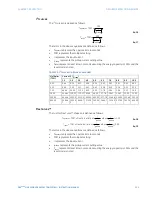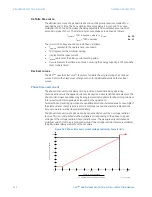
CHAPTER 7: PROTECTION
GROUPED PROTECTION ELEMENTS
D90
PLUS
LINE DISTANCE PROTECTION SYSTEM – INSTRUCTION MANUAL
223
multiple points. A fault beyond 100% of the protected line may cause overreach unless the
reach is reduced significantly, sometimes as low as 65% of the line length. If the line being
protected does not have a significant interaction with an adjacent circuit, then the typical
80% setting may be used. If there is significant mutual coupling between the parallel lines,
then the mutual compensation feature of the ground distance elements can be used
instead of a drastic reduction in the reach.
However, even in this case, there is more uncertainty as compared with the phase distance
elements because the zero-sequence impedance of the line and thus the zero-sequence
compensating factors may vary significantly due to weather and other conditions.
Ground distance zone 2 guidelines for the stepped distance scheme
To ensure that the zone 2 can see 100% of the line, inter-circuit mutual effects must be
considered, as they can contribute to a significant under-reach. Typically this may occur
on double circuit lines, when both lines may carry the same current. An analytical study
should be carried out to determine the appropriate reach setting.
The main purpose of this element is to operate for faults beyond the reach of the local zone
1 element, and therefore a time delay must be used similar to the phase fault case.
Ground distance zone 3 guidelines for the stepped distance scheme
This remote back up function must have a reach which is set to account for any infeed at
the remote bus, plus the impedance of the longest line which terminates on this remote
bus. Similar to the phase fault case, a zone 3 element must be time coordinated with timed
clearances on the next section.
Ground distance zone 4 guidelines for the stepped distance scheme
As a further contribution to a remote backup philosophy, the reach of this element must be
set to account for any infeed at the remote bus. The time delay must coordinate with other
time-delayed protections on the next line. The use of a lens characteristic or load
encroachment element may be advantageous if load limits are a problem. To avoid
extremely large reach settings, the D90
Plus
has the ability to implement any element so
that it is reverse-looking. This strategy can be beneficial if the reduced reach enhances the
discrimination between the load and fault conditions. It should be recognized however
that, if adopted, this approach must be implemented at both ends of the protected line.
Ground distance zone 5 guidelines for the stepped distance scheme
An additional fifth ground distance zone can be used in special applications. This zone may
be start zone for arming tripping from all other zones, in both forward and reverse
directions of the of protected line. This zone may also be used as an additional reverse-
looking zone for implementation of two reverse-looking zones, thus providing two zone
backup reverse-looking protection. The fifth distance zone can be used as an alarm zone,
indicating that load impedance is approaching the zone characteristic.
Series compensated line protection application guidelines
This section provides general application guidelines for implementing protection for series
compensated lines with the D90
Plus
.
It is recommended to apply a combination of distance, ground directional overcurrent, and
high-set overcurrent functions for protection of series compensated lines. The setting rules
described below must take into account variety of system configurations, particularly a
status of series capacitors (in-service, by-passed). Either the worst-case topology shall be
considered or – if possible – adaptive settings shall be applied though the multiple settings
groups mechanism.
















































